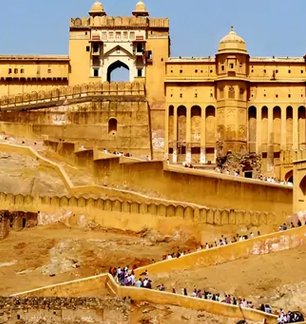Contact Us : +91-9354084237 contact@ranthamboretigereserve.in
Contact Us : +91-9354084237 contact@ranthamboretigereserve.in
Snuggled within Rajasthan’s Sawai Madhopur district, Ranthambore National Park is acclaimed as one of India’s top wildlife havens, boasting a captivating blend of natural beauty and rich historical legacy. Known for its thriving tiger population and dramatic landscape, the park has a fascinating past that reflects centuries of royal legacy, conservation evolution, and ecological transformation.
The name Ranthambore originates from the historic Ranthambore Fort, a majestic structure perched on a hilltop inside the reserve. This ancient fort, dating back to the 10th century, once served as a stronghold for several Rajput kings and later witnessed the reign of several ruling dynasties including the Delhi Sultanate and the Mughals. Over time, the fort transformed into a symbol of strength and resilience and today is a UNESCO World Heritage Site that overlooks the heart of the national park.
At first, the areas surrounding the fort were designated as exclusive hunting grounds for the Maharajas of Jaipur. Due to its rugged terrain and inaccessibility, this region remained untouched and flourished with wildlife. Occasional royal hunting expeditions took place here, but large areas of the jungle remained undisturbed for decades. The local villagers, who lived in and around the forest, were allowed limited usage under the governance of the royal family, maintaining a delicate balance between people and nature.

The post-independence period marked a shift in land use and forest policies across India. With increasing pressure from agriculture, human population, and deforestation, the once-protected forests began facing rapid degradation. The Rajasthan government in 1953, implemented the Rajasthan Forest Act to stop harmful activities and aim for sustainable forest management. Following this legislative move, the Sawai Madhopur Wildlife Sanctuary was officially established in 1955, providing the first level of legal protection to the Ranthambore forest region.
A significant milestone in the conservation journey came in 1973 when Ranthambore was selected as part of India’s first Project Tiger initiative. Project Tiger aimed to provide safe and secure habitats for tigers across the country was introduced by the Government of India to save the endangered Bengal tiger. Ranthambore, due to its ideal forest cover, water bodies, and prey base, became one of the first nine tiger reserves under the program. A dedicated area was demarcated, and strong conservation measures were introduced with the aim to protect tigers and their natural habitat while regulating human interference.
In 1980, Ranthambore was officially declared a national park after relocating over 12 villages from the core forest zone. This move enabled the park to increase its protected area and minimize human-wildlife conflict. The park’s boundaries were eventually expanded further with the addition of the Kela Devi Sanctuary to the north in 1983 and the Sawai Mansingh Sanctuary to the south in 1984. Today, these areas combine to form the Ranthambore Tiger Reserve, which spans over 1,334 square kilometers.
Thanks to sustained conservation measures and the rigorous application of wildlife protection laws, Ranthambore has witnessed a consistent growth in its tiger population. From just a handful of tigers during the initial phase, the population grew to 64 tigers by 2014, making it one of India’s most successful tiger reserves. This resurgence of wildlife has not only strengthened biodiversity but has also helped Ranthambore emerge as a top eco-tourism destination attracting wildlife enthusiasts, conservationists, and travelers from around the world.
What really differentiates Ranthambore is the symphonic combination of its vibrant wildlife and ancient historical structures. Visitors can witness tigers roam freely in the shadow of ancient forts, temples, and royal ruins, an experience that combines the thrill of a safari with the wonder of stepping back in time. Structures like Padam Talao, Rajbagh Palace, and the Ranthambore Fort offer an atmospheric backdrop to the park’s rich natural legacy.
Today, Ranthambore National Park is a symbol of prosperous wildlife conservation in India. With its captivating history, remarkable biodiversity, and commitment to conservation, the park continues to inspire and educate generations about the importance of protecting and cherishing our natural heritage.